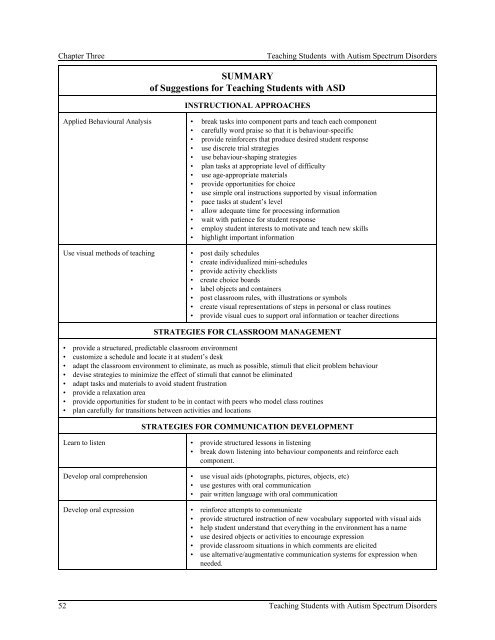Teaching Students with Autism Spectrum Disorders
Teaching Students with Autism Spectrum Disorders
Teaching Students with Autism Spectrum Disorders
Create successful ePaper yourself
Turn your PDF publications into a flip-book with our unique Google optimized e-Paper software.
Chapter Three <strong>Teaching</strong> <strong>Students</strong> <strong>with</strong> <strong>Autism</strong> <strong>Spectrum</strong> <strong>Disorders</strong><br />
SUMMARY<br />
of Suggestions for <strong>Teaching</strong> <strong>Students</strong> <strong>with</strong> ASD<br />
INSTRUCTIONAL APPROACHES<br />
Applied Behavioural Analysis • break tasks into component parts and teach each component<br />
• carefully word praise so that it is behaviour-specific<br />
• provide reinforcers that produce desired student response<br />
• use discrete trial strategies<br />
• use behaviour-shaping strategies<br />
• plan tasks at appropriate level of difficulty<br />
• use age-appropriate materials<br />
• provide opportunities for choice<br />
• use simple oral instructions supported by visual information<br />
• pace tasks at student’s level<br />
• allow adequate time for processing information<br />
• wait <strong>with</strong> patience for student response<br />
• employ student interests to motivate and teach new skills<br />
• highlight important information<br />
Use visual methods of teaching • post daily schedules<br />
• create individualized mini-schedules<br />
• provide activity checklists<br />
• create choice boards<br />
• label objects and containers<br />
• post classroom rules, <strong>with</strong> illustrations or symbols<br />
• create visual representations of steps in personal or class routines<br />
• provide visual cues to support oral information or teacher directions<br />
STRATEGIES FOR CLASSROOM MANAGEMENT<br />
• provide a structured, predictable classroom environment<br />
• customize a schedule and locate it at student’s desk<br />
• adapt the classroom environment to eliminate, as much as possible, stimuli that elicit problem behaviour<br />
• devise strategies to minimize the effect of stimuli that cannot be eliminated<br />
• adapt tasks and materials to avoid student frustration<br />
• provide a relaxation area<br />
• provide opportunities for student to be in contact <strong>with</strong> peers who model class routines<br />
• plan carefully for transitions between activities and locations<br />
STRATEGIES FOR COMMUNICATION DEVELOPMENT<br />
Learn to listen • provide structured lessons in listening<br />
• break down listening into behaviour components and reinforce each<br />
component.<br />
Develop oral comprehension • use visual aids (photographs, pictures, objects, etc)<br />
• use gestures <strong>with</strong> oral communication<br />
• pair written language <strong>with</strong> oral communication<br />
Develop oral expression • reinforce attempts to communicate<br />
• provide structured instruction of new vocabulary supported <strong>with</strong> visual aids<br />
• help student understand that everything in the environment has a name<br />
• use desired objects or activities to encourage expression<br />
• provide classroom situations in which comments are elicited<br />
• use alternative/augmentative communication systems for expression when<br />
needed.<br />
52 <strong>Teaching</strong> <strong>Students</strong> <strong>with</strong> <strong>Autism</strong> <strong>Spectrum</strong> <strong>Disorders</strong>

















